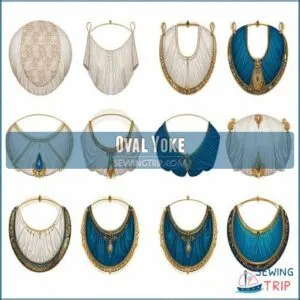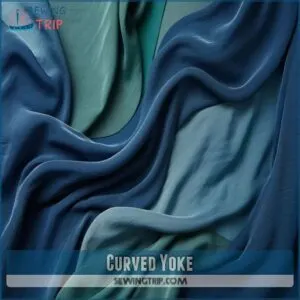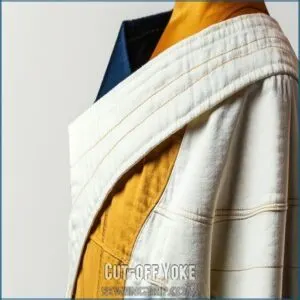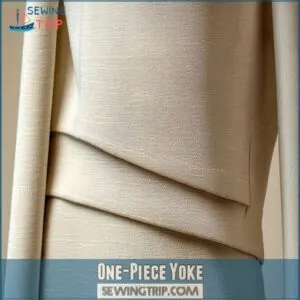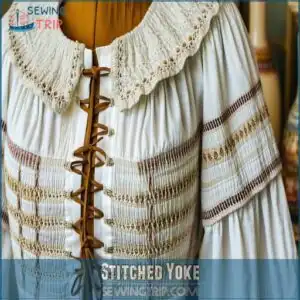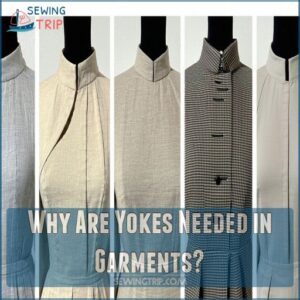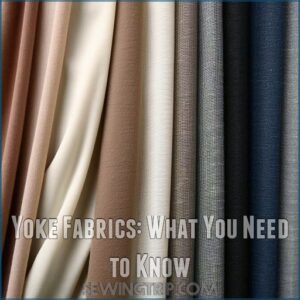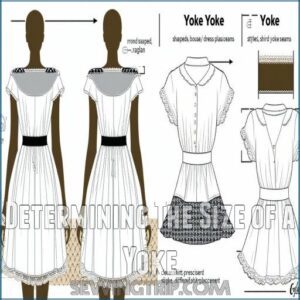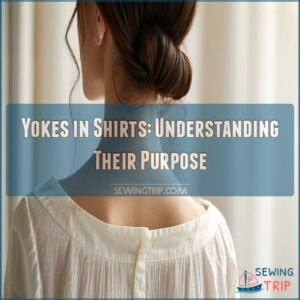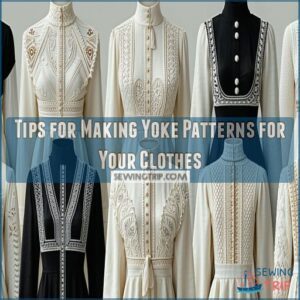This site is supported by our readers. We may earn a commission, at no cost to you, if you purchase through links.
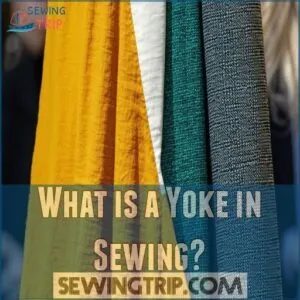
It’s a shaped fabric panel that hugs your shoulders or waist, adding structure and flair to shirts, dresses, and more.
Think of it as the superhero of your wardrobe – quietly working behind the scenes to improve fit and create eye-catching designs.
Whether it’s a smooth oval yoke or a chic cut-off style, this clever pattern piece absorbs fullness, defines curves, and lets you play with embellishments.
Intrigued by how a simple panel can revolutionize your clothing? Stick around for some game-changing yoke insights.
Table Of Contents
- Key Takeaways
- What is a Yoke in Sewing?
- Different Types of Yokes in Clothing
- Why Are Yokes Needed in Garments?
- Yoke Fabrics: What You Need to Know
- Determining The Size of a Yoke
- Yokes in Shirts: Understanding Their Purpose
- Sewing a Yoke: Connecting The Strips at an Angle
- Tips for Making Yoke Patterns for Your Clothes
- Frequently Asked Questions (FAQs)
- Conclusion
Key Takeaways
- You’ll transform your garments from basic to professional by mastering the yoke—a strategic fabric panel that controls fit, shape, and structural integrity across shoulders or waistlines.
- By experimenting with different yoke types like oval, curved, and cut-off styles, you’ll unlock endless design possibilities that add unique character to your clothing.
- Choosing the right fabric for your yoke is crucial—matching weight, drape, and texture ensures your garment looks polished and moves comfortably.
- You can use yokes creatively to absorb fullness, define curves, and showcase your sewing skills through embellishments like embroidery, contrasting fabrics, or decorative stitching.
What is a Yoke in Sewing?
A yoke is like the secret ingredient that turns a plain garment into a well-fitted masterpiece. In sewing, a yoke is a shaped fabric panel added at the shoulders or waist to control fit and shape.
Think of it as the backbone of good design—it keeps things structured while giving you room to play with style.
Whether you’re tracing patterns for a casual tunic or crafting a custom-fit shirt, yokes offer endless design possibilities. You can go simple with straight lines or experiment with curves and pointed edges.
Fabric choice matters too—pick sturdy, smooth fabrics like silk twill for crisp results.
Yokes also invite creativity: try embroidery, lace, or even contrasting prints for flair. When executed well, a yoke showcases skill and transforms garments into polished, eye-catching pieces.
Different Types of Yokes in Clothing
Yokes come in all shapes and styles, each bringing its own flair to your garments. From sleek curves to bold, geometric lines, you’ve got plenty of options to explore.
Oval Yoke
An oval yoke is your secret to chic shoulder shaping with a touch of creativity. Its swooping design flatters the upper body and works wonders with embellishments like embroidery.
- Use a bias cut to enhance fluidity and drape.
- Play with yoke embellishment ideas for standout designs.
- Perfect oval yoke placement for polished results.
Curved Yoke
Curved yokes bring elegance and functionality, contouring shoulders with smooth, flowing lines.
They’re perfect for adding depth using darts or pleats—think classic yet stylish.
Try mixing rounded and angled edges for eye-catching designs.
Careful fabric choice impacts drape, so choose wisely.
Embrace curved yoke patterns to create sleek, polished shapes that elevate your sewing game effortlessly.
Cut-off Yoke
A cut-off yoke adds an edgy twist to your garment by ditching the straight-across look for angles and curves.
- Try asymmetry by shortening one side for a bold statement.
- Experiment with sharp angles or soft curves—both give unique vibes.
- Add decorative trim to the edge for extra flair.
- Highlight with contrasting stitches to make the details pop.
Cut-off yoke variations let you break the rules and play with design. Angled yoke sewing offers endless creative freedom, transforming basic patterns into head-turning, personalized looks that are all about you!
One-Piece Yoke
The one-piece yoke is your go-to for clean, seamless looks.
Explore one-piece variations like one-seam for sleek lines, darted for shaping, gathered for softness, or pleated for texture.
Adjust patterns, pick fabrics wisely, and solve fitting issues effortlessly for a polished finish.
Stitched Yoke
A stitched yoke opens the door to endless creativity, letting you flex your sewing skills with artistic touches. Ready to experiment? Try these ideas:
- Use yoke embellishments, like decorative stitching, shadow box effects, or embroidery, for a unique pop.
- Add texture with smocking, ruching, or pleated details.
- Play with contrasting fabrics, like combining lace and satin, for bold yoke variations.
- Enhance edges with bias binding or vibrant piping.
- Showcase your sewing techniques by layering fabrics with precision.
Every stitched yoke transforms your garment into wearable art.
Why Are Yokes Needed in Garments?
Ever wonder why garments look polished and fit so perfectly? That’s often thanks to the clever use of yokes. These fabric panels streamline garment shaping by absorbing fullness without darts, making them a clean, professional design element.
When you’re aiming for precise fit improvement, like over the bust, try a set-in yoke. It hugs your curves while keeping lines smooth. Whether you’re a beginner or an experienced sewer, finding the right yoke sewing pattern can make a significant difference in the overall look of your garment.
For a softer, flowing silhouette, extended shoulder yokes are your go-to, while a cut-on yoke can tidy up gathers around the waist in a blouse. Drop shoulder yokes? Perfect for relaxed ease of movement—think casual shirts or comfy tops. A well-placed yoke can also add character, like the sporty vibe of a contrasting yoke on a baseball tee or the drama of uniquely shaped designs like diamond or U-shaped yokes.
Not just practical, yokes in garment construction are also a playground for creativity. Mix solids with prints or draft a rounded yoke for a touch of elegance. The benefit of yokes in sewing lies in combining fit, structural support, and style—helping your designs reach couture-level sophistication with ease.
Yoke Fabrics: What You Need to Know
When it comes to yoke fabrics, picking the right one makes or breaks your project. Think about the fabric weight and drape—light fabrics like chiffon or silk crepe work wonders for soft blouses, while medium-weight options like cotton or linen are perfect for structured shirts. For outerwear yokes, sturdier materials like denim or wool give the support and structure you need. Matching the yoke fabric to the main fabric also guarantees compatibility with care instructions, especially when opting for split yoke designs.
Matching the yoke fabric to the main fabric is a safe bet, guaranteeing compatibility with care instructions and finish. If you’re feeling creative, mix things up with contrasting textures, patterns, or colors to make the yoke pop. Just imagine a crisp white shirt with a chambray yoke—classic yet unexpected.
Don’t forget how the fabric behaves during sewing. Slippery or stretchy materials might need stabilizers to avoid puckering. Curved seams especially demand attention. You’ll want smooth, crisp stitching for a polished look. For delicate fabrics, try finishes like a Hong Kong seam to keep frays and frustrations at bay.
Considering embellishments? Pick fabrics that showcase details like topstitching or embroidery beautifully. By understanding fabric characteristics, you’ll create yokes that aren’t just functional—they elevate your garment to the next level. Fabric characteristics are important.
Determining The Size of a Yoke
Determining the yoke size for your project is vital for a perfect fit and smooth finish. Accurate measurements help avoid awkward fits, while pattern adjustments handle dart placements or pleats. Keep fabric shrinkage in mind, especially for natural fibers.
The yoke’s role in connecting fabric panels and providing structure, as seen in traditional clothing designs, is essential for a polished result.
Here’s how to nail it:
- Shoulder span and style: Measure the shoulder width for a bodice and decide if the yoke will be 2-4 inches below the shoulder.
- Seam allowances: Add 1/4” to 5/8” for neat yoke-bodice attachment points.
- Shaping techniques: Adjust for pleats, gathers, or smocking within the yoke measurement.
- Final fitting: Check the symmetrical alignment of darts or patterns to refine your design.
Understanding yoke size impact guarantees a polished result every time!
Yokes in Shirts: Understanding Their Purpose
Think about your favorite shirt – that neat piece at the shoulders, just under the collar, is the yoke. It’s more than just a fabric panel; it’s the foundation for fit and flair. The yoke shapes the neckline and keeps the shoulder seams sitting just right. Ever notice how your back moves freely in a well-made shirt? That’s the yoke at work, absorbing ease for movement.
By using various sewing techniques, you can create different yoke styles, from subtle pleats to bold gathers, and add character to your shirt. And it’s not all function! Yokes let you have fun with design. Whether it’s contrasting fabrics, or embroidered initials, yokes add character to your shirt.
Here’s how the yoke affects your shirt:
| Feature | Purpose | Effect | Design Tip |
|---|---|---|---|
| Fabric choice | Structure and comfort | Smooth neckline | Use sturdy fabrics for structure |
| Pleats/Gathers | Added ease | Shoulder mobility | Try subtle details for flair |
| Shape | Fits shoulders | Clean, polished look | Check patterns for precision |
| Decorative options | Style impact | Unique, bold designs | Experiment with contrasting fabrics or trims |
Sewing a Yoke: Connecting The Strips at an Angle
When attaching a yoke, connecting strips at an angle might sound tricky, but it’s easier than you’d think. It’s all about precision and neat corners. Start by ensuring your fabric edges align perfectly—fabric matching counts big time here! To avoid sewing techniques, pin the strips together, keeping the yoke seam flat and smooth. Pick a stitch selection that works with your fabric; a straight stitch is a solid go-to.
Once stitched, pressing techniques are the secret weapon. Press the seam open first for a sharp look, then press it toward the yoke for a crisp finish. For those angled seams, trim excess bulk to avoid puckering.
- Use light tacks for tricky sections.
- Trim seam allowances slightly for clean angles.
- Check alignment before sewing—it saves headaches.
Tips for Making Yoke Patterns for Your Clothes
Creating yoke patterns might sound tricky, but it doesn’t have to be!
With a few smart tips and some patience,
you’ll have clean, precise designs that elevate your sewing projects.
Simple Round Yoke
A simple round yoke brings elegance to your garment, framing your shoulders with soft curves.
Cut two matching rounded pieces from your chosen yoke fabric.
Burrito-style sewing neatly hides raw edges for a polished finish.
To personalize, try subtle topstitching or embroidery. Round yoke sewing patterns work beautifully with solid or contrasting fabrics for added charm.
Full Round Yoke
A full round yoke hugs your shoulders like a cozy wrap, softening the garment’s look.
Perfect for relaxed fits, it extends beyond shoulder points and works beautifully in sleeved designs.
Experiment with fabric choices and clever yoke sewing techniques.
Straight Yoke
A straight yoke adds crisp, modern appeal to your garment, offering clean lines and versatility.
Experiment with straight yoke designs like pairing with side panels for sleek shaping or using lace or mesh for texture.
A split yoke design offers better flexibility and fit when working with fabrics that stretch diagonally.
Perfect for straight yoke blouses or coats, this style elevates your look while its straightforward yoke seam finishes guarantee a polished result.
Square Yoke Pattern
Your designer’s square yoke is a geometric gem that transforms ordinary garments into fashion statements. Here’s how to nail this trendsetting technique:
- Crisp shoulder lines that slice through convention
- Asymmetrical edges that whisper rebellion
- Unexpected fabric contrasts that spark conversation
- Angular silhouettes breaking traditional boundaries
- Structural drama that turns heads
Master the square yoke, and you’ll elevate your sewing game from basic to brilliant.
Frequently Asked Questions (FAQs)
What is a yoke pattern?
Hold onto your sewing needles!
A yoke pattern is a blueprint
that sketches out the distinctive fabric panel shaping shoulders or waistlines,
guiding you to cut and construct unique, perfectly-fitted garment sections.
What is a yoke in fashion?
A yoke is a stylish fabric panel.
It gives clothes structure and shape.
Strategically placed at shoulders or waist to enhance fit, create visual interest, and add a professional touch to garments.
What is a yoke & how does it work?
Like a sculptor’s frame guiding fabric’s destiny, a yoke shapes your garment’s personality.
It’s a strategic panel that adds structure, comfort, and style.
transforming ordinary clothing into a custom-made masterpiece with precision and elegance.
Is it easy to sew a yoke?
Sewing a yoke isn’t rocket science, but it does take practice.
You’ll nail it with patience, precise pinning, and careful pressing.
Start with simple patterns, watch tutorials, and don’t get discouraged—your skills will improve with each try!
Why is the yoke important in sewing patterns?
Sculpting fabric like an artist’s brushstroke, the yoke is your pattern’s secret weapon.
It’ll transform your garment’s fit.
It’ll add structural integrity.
It’ll elevate your design from basic to breathtaking with minimal effort and maximum impact.
What is a yoke on a shirt?
A shirt’s yoke is the structured panel across your shoulders.
It shapes the garment, distributes fabric weight, and adds a polished look.
It’s like a custom foundation that transforms a plain shirt into a stylish piece.
What is the purpose of a yoke in sewing?
Crafting garment architecture, a yoke elegantly supports your shoulders like a maverick blueprint.
It’s your fabric’s secret weapon, shaping comfort, and adding style.
Transforming ordinary clothing into custom-fit masterpieces with precision and panache.
Where is the yoke on a garment?
You’ll typically find yokes at the shoulders of shirts, across the back or front, and sometimes at the waist of dresses or skirts.
They’re strategic design elements.
They shape, support, and add visual interest to your garment.
What are the two types of yoke?
When diving into sewing, you’ll discover two main yoke types: the set-in yoke, which creates precise shaping,
and the extended shoulder yoke, delivering softer silhouettes that’ll elevate your garment’s design and comfort.
What is a yoke on pants?
On pants, the yoke’s that curved or straight panel sitting at the back waistline.
It shapes your fit, adds comfort, and gives your jeans or trousers a smooth, streamlined look.
That hugs your body just right.
Conclusion
Ready to elevate your sewing game? The yoke isn’t just a fabric panel—it’s your secret weapon for stunning garments.
Whether you’re crafting a shirt, dress, or blouse, understanding what a yoke in sewing is can transform your designs from basic to breathtaking.
Experiment with different styles, play with angles, and watch your clothing come alive with professional-looking structure and flair. Your wardrobe will thank you for mastering this game-changing sewing technique!

